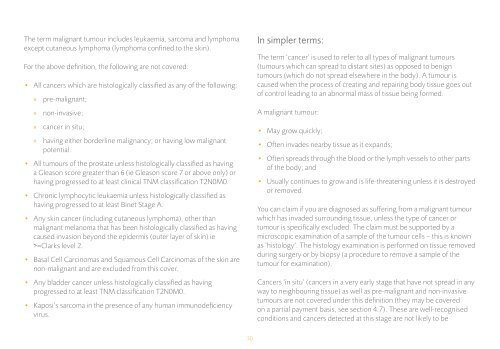Mortgage Protection booklet - Irish Life
Mortgage Protection booklet - Irish Life
Mortgage Protection booklet - Irish Life
You also want an ePaper? Increase the reach of your titles
YUMPU automatically turns print PDFs into web optimized ePapers that Google loves.
The term malignant tumour includes leukaemia, sarcoma and lymphoma<br />
except cutaneous lymphoma (lymphoma confined to the skin).<br />
For the above definition, the following are not covered:<br />
• All cancers which are histologically classified as any of the following:<br />
» pre-malignant;<br />
» non-invasive;<br />
» cancer in situ;<br />
» having either borderline malignancy; or having low malignant<br />
potential.<br />
• All tumours of the prostate unless histologically classified as having<br />
a Gleason score greater than 6 (ie Gleason score 7 or above only) or<br />
having progressed to at least clinical TNM classification T2N0M0.<br />
• Chronic lymphocytic leukaemia unless histologically classified as<br />
having progressed to at least Binet Stage A.<br />
• Any skin cancer (including cutaneous lymphoma), other than<br />
malignant melanoma that has been histologically classified as having<br />
caused invasion beyond the epidermis (outer layer of skin) ie<br />
>=Clarks level 2.<br />
• Basal Cell Carcinomas and Squamous Cell Carcinomas of the skin are<br />
non-malignant and are excluded from this cover.<br />
• Any bladder cancer unless histologically classified as having<br />
progressed to at least TNM classification T2N0M0.<br />
• Kaposi’s sarcoma in the presence of any human immunodeficiency<br />
virus.<br />
30<br />
In simpler terms:<br />
The term ‘cancer’ is used to refer to all types of malignant tumours<br />
(tumours which can spread to distant sites) as opposed to benign<br />
tumours (which do not spread elsewhere in the body). A tumour is<br />
caused when the process of creating and repairing body tissue goes out<br />
of control leading to an abnormal mass of tissue being formed.<br />
A malignant tumour:<br />
• May grow quickly;<br />
• Often invades nearby tissue as it expands;<br />
• Often spreads through the blood or the lymph vessels to other parts<br />
of the body; and<br />
• Usually continues to grow and is life-threatening unless it is destroyed<br />
or removed.<br />
You can claim if you are diagnosed as suffering from a malignant tumour<br />
which has invaded surrounding tissue, unless the type of cancer or<br />
tumour is specifically excluded. The claim must be supported by a<br />
microscopic examination of a sample of the tumour cells – this is known<br />
as ‘histology’. The histology examination is performed on tissue removed<br />
during surgery or by biopsy (a procedure to remove a sample of the<br />
tumour for examination).<br />
Cancers ‘in situ’ (cancers in a very early stage that have not spread in any<br />
way to neighbouring tissue) as well as pre-malignant and non-invasive<br />
tumours are not covered under this definition (they may be covered<br />
on a partial payment basis, see section 4.7). These are well-recognised<br />
conditions and cancers detected at this stage are not likely to be

















